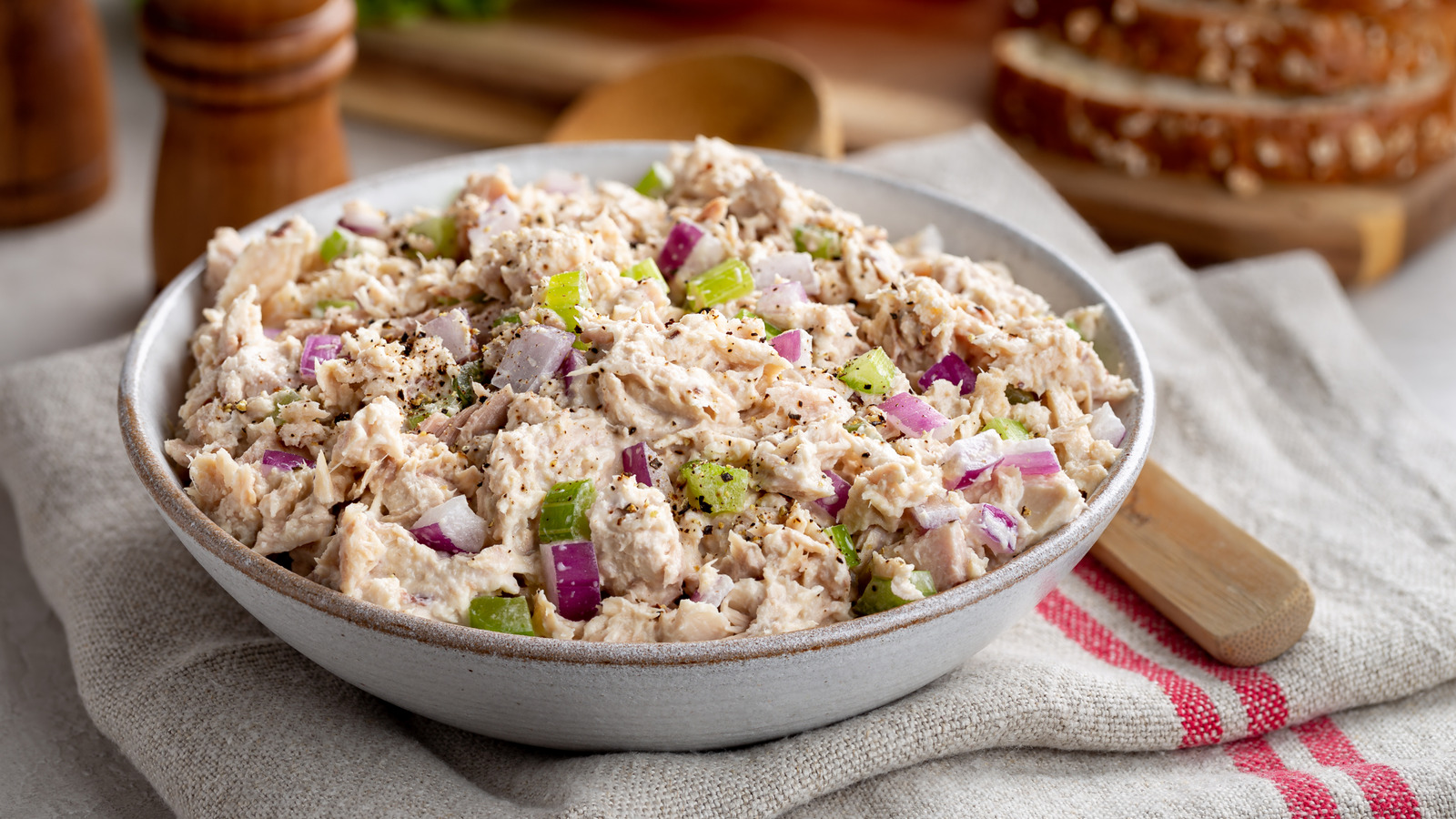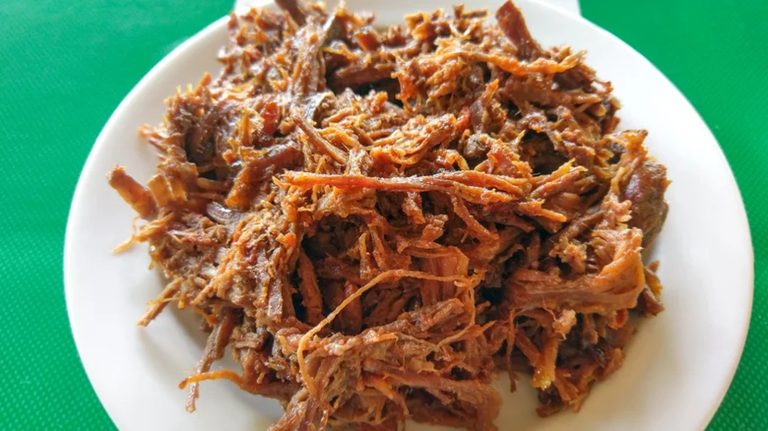Tuna salad has long been a lunchbox mainstay, but not because everyone was wildly in love with it. Rather, it was because canned tuna was historically cheap and easy to keep around the house: Even after months in the pantry, those trusty cans still made a wholesome and hearty lunch. A basic tuna salad sandwich was quick and easy to put together — just drain the can, mix with some mayo, slap it between two pieces of bread, and you’ve got lunch.
But as anyone who survived a childhood of these bare-bones sandwiches can attest, they’re filling but not terribly exciting. But tuna salad doesn’t have to be boring — with just a few well-chosen ingredients and a little creativity, you can turn an unglamorous can of tuna into something you’ll actually look forward to eating. And some of the best — and maybe most surprising — additions to tuna salad are those that augment tuna’s naturally savory, umami flavor. Give some of these a try — you’ll never think of canned tuna in the same way again.
1. Miso
Living on a group of islands with limited arable land compelled Japanese cooks to look to the sea for sustenance, and centuries of experience turned them into masters of seafood cookery. When most of us think of Japanese food, their unique seafood specialties such as sushi, sashimi, and shrimp tempura, are among the first dishes that come to mind.
Japanese cooks discovered that many of their homegrown ingredients and flavorings were perfect complement for fish. For instance, miso — a salty, savory paste made from fermented soybeans and grains — is a great match for rich, oily fish such as salmon. Miso’s distinctive, earthy flavor and hint of sweetness are bold enough to balance out strong, fishy flavors, which is why it’s a popular ingredient in glazes for broiled fish. For the same reason, it’s a great addition to a basic tuna salad – just mix a bit of miso into your mix along with mayo and classic chopped celery and scallions. It’ll look like a basic tuna salad — but the hidden hit of miso will take the flavor to the next level.
2. Furikake
Furikake is a Japanese kitchen staple with no real analog in American culinary culture. But once you’ve tried it and discovered its potential, you’ll wonder how you ever lived without it. It’s a dry condiment of dried seaweed flakes, sesame seeds, and other flavorings that can include dried fish or bits of dried vegetables. Traditionally, Japanese diners sprinkled it onto plain rice to make it more interesting, but Western cooks have discovered that it’s also a tasty topping for popcorn as well as a great flavoring for snack mixes, and a pretty and flavorful table garnish for tofu, seafood dishes, and even avocado toast.
Much of its appeal comes from the fact that it delivers a serious hit of umami — it adds an extra dose of savoriness to everything it touches. And the glossy seaweed flakes and sesame seeds add a bit of color contrast to monochrome dishes. All of this make furikake a tasty — and easy — addition to tuna salad. Just add a sprinkle or two (or three) of furikake and a few squirts of Sriracha to your next tuna salad for a spicy-tuna-roll-inspired twist. This version is just as good stuffed into halved cucumbers for a refreshing salad as it is in a sandwich.
3. Mushroom powder
Mushrooms are among the foods known to be rich in umami-bearing flavor compounds, and dried mushrooms have an even greater concentration of these. This is why dried mushrooms are a kitchen staple in Chinese and other cultures — they not only extend the shelf life of delicate fresh mushrooms, they offer an even deeper and more intense flavor than their fresh counterparts.
To concentrate this rich flavor even more, some cooks grind dried mushrooms to transform them into mushroom powder. A few pinches of this will add new depth and richness to eggs, sauces, and even granola and baked goods, without a flavor that screams “Mushrooms!” This makes mushroom powder a great secret ingredient to have on hand if you want to up the umami quotient in a dish but not drown out other flavors. And a good place it can used for this purpose is in tuna salad — a pinch or two stirred into your favorite recipe will give your tuna salad extra oomph while preserving its flavor profile.
4. Fish sauce
A cautious cook may think the last thing a strongly flavored fish like tuna needs is more fishy flavors, but hear us out: As fans of triple-chocolate-everything can attest, sometimes the best thing you can do with a powerful flavor is double down and really celebrate it. And if you enjoy tuna but find yourself with a bland-tasting can of the stuff, a touch of fish sauce be a useful way to bring back its natural umami brininess.
If you’re not familiar with it, fish sauce is a staple of Southeast Asian cuisine — if you’ve ever dined at a Vietnamese or Thai restaurant, you’ve almost certainly encountered it. It’s a thin, salty sauce made from fermented fish and salt, and serves a similar role in Thai and Vietnamese dishes as soy sauce in Chinese cooking. It can be intimidating to novices since a whiff or spoonful straight from the bottle may seem unpleasantly salty and pungent. But used as intended — in small quantities, along with other ingredients to balance it out — it adds a distinctive hit of umami richness. Just half a teaspoon will be enough to enliven an otherwise boring tuna salad.
5. Anchovy paste
Fish as a seasoning for other fish may sound weird and redundant, but it’s a time-honored strategy. For instance, several classic dishes of the Mediterranean feature tuna accentuated with anchovies. Vitello tonnato, a favorite in Italy, features cold, sliced veal or other mild meat topped with a creamy mayonnaise-like sauce enhanced with puréed tuna and anchovies. And in the south of France, pan bagnat — arguably the king of tuna salad sandwiches — features tuna and anchovy strips piled onto a roll alongside olives and fresh vegetables. In neither case do the anchovies overwhelm the tuna (nor the eater) — instead, they accentuate the tuna’s flavor while adding a bit of salty sharpness and umami.
An easy way to achieve the same effect with a basic tuna salad is to add a bit of anchovy paste. The salty, fishy condiment, sold in small tubes, packs the same fishy punch as whole anchovies, so a little goes a long way. Some cooks love the convenience of anchovy paste — it’s an easy way to add the umami flavor of anchovies without chopping (or worrying about what to do with the rest of an open can of anchovies). And nothing could be faster or simpler than stirring a tiny squirt of it into your tuna salad.
6. Tomatoes
Tuna salad doesn’t have to go inside a sandwich. A classic way to elevate it into a plated entrée for a summer lunch is to stuff it into a tomato. This combo works for a number of reasons. For once, it’s pretty to look at — the brightness of the tomato adds visual excitement to an otherwise unremarkable-looking tuna-mayo salad. Second, the contrast between the firm juiciness of the tomato and the creaminess of the tuna salad is just fun to eat. And most importantly, tomatoes add a serious boost of umami to the mix, making a good tuna salad even better.
Indeed, tomatoes are among the most umami-rich fruits or vegetables, with a higher percentage of glutamates – the amino acid that contributes umami flavors — than most other produce. This may be why tomatoes are among the most popular vegetables (fruit, to be technically correct) in the world’s cuisines. And a bit of chopped tomato makes a refreshing addition to a tuna salad, adding color and tang along with a welcome boost of umami. Try adding tomatoes along with some chopped cucumber for a light, summery take on the classic.
7. Capers
Rich fish dishes often benefit from tangy accents — that wedge of lemon alongside your grilled fish is there for a reason. Cooks love to add zingy ingredients such as pickle relish and mustard to tuna salad because of the brightness they bring to what could be a heavy, one-note dish. But if you’re looking for a way to add some tang to your tuna salad while also upping its umami flavors, consider a classic Italian partner for seafood: capers.
Capers may look like tiny peas or swollen green peppercorns, but in reality, they’re tiny, unopened flower buds of a bush native to the Mediterranean. Cooks there figured out how to harvest the little buds and preserve them in salt, vinegar, or brine for use as a flavorful condiment. Their tangy, earthy flavor is a great complement to fish, including tuna — and there’s no reason you can’t stir some into your tuna salad for extra color and flavor. Indeed, Julia Child’s favorite tuna salad recipe features capers — and if they were good enough for Julia, they’re good enough for you.
8. Pickles
When brainstorming about familiar dishes and ways to improve them, we don’t always need to reinvent the wheel. Old and familiar flavorings and flavor combinations have staying power because they simply work. For instance, chopped pickles are among the most familiar additions to tuna salad, and hardly anyone would be surprised to see them there.
So why are pickles such a good partner for tuna? For one, they add a welcome shot of tanginess, crunch, and color. And your choice of pickle can completely change the personality of your tuna salad: While some eaters love to add sweet pickles or pickle relish, others prefer the more savory, puckery notes of dill pickles. In addition, pickles can augment the umami flavor of tuna, especially if they’re pickled by natural fermentation, rather than the faster and more common method of vinegar pickling. But if you’re making your own vinegar-pickled cucumbers, you can employ a quick cheat to boost their umami — just slip a bit of MSG into the brine and allow the pickles to cure as usual.
9. Soy sauce
Soy sauce is a powerful umami booster. Made from fermented soybeans, wheat, and salt, it boasts a high concentration of umami-producing glutamates, which is why we’re so often drawn to soy-based dipping sauces. Sushi lovers know how nicely soy sauce complements fresh, raw tuna (and other fish, for that matter). Besides adding a welcome bit of salt, the sauce’s umami notes make the fish seem even richer and more buttery and satisfying. It’s probably no coincidence that a number of Japanese tuna dishes other than sushi — such as braised tuna — feature soy sauce as a dominant flavoring.
This means soy sauce can also be a flavorful addition to a simple tuna salad. Like many other umami-boosting ingredients, it’s able to work its magic even when used in small quantities. Thus, a good trick for tuna salad is to add just a splash — enough to bring out the flavor of the fish, but not enough to contribute a notable flavor note of its own. And while you can lean into the Asian flavor palette and season your salad with sesame seeds and ginger, you don’t have to. A touch of soy sauce can elevate even an old-school tuna salad with celery and pickles.
10. Worcestershire sauce
Impossible to pronounce and almost as difficult to ignore, Worcestershire sauce is another powerfully flavored umami bomb. Like soy sauce and fish sauce, it gets its intense umami flavoring through fermentation and aging. Unlike soy sauce or fish sauce, it has an assertive tang from malt vinegar and tamarind, along with warmth from spices such as cloves and peppercorns. Its vaguely South Asian flavor profile reflects its history — according to Lea & Perrins, the creators of the original Worcestershire sauce, the condiment originated as a commission from a noble who’d returned from India with a bottle of sauce and charged dispensing chemists John Lea and William Perrins with the task of reproducing it.
Their mission was a success, and cooks have been using Worcestershire sauce ever since to add zing and umami depth to soups, sauces, and more. It’s also a great secret ingredient in a tuna salad. As with fish sauce or soy sauce, the trick is to add just enough to boost the tuna’s umami flavor, but not enough to overwhelm the other flavors. Just half a teaspoon of Worcestershire (for two 5-ounce cans of tuna) should be enough to elevate your favorite tuna salad recipe.
11. Dashi
Dashi, an umami-rich broth of kombu (a type of seaweed), dried bonito flakes, and sometimes ingredients such as dried mushrooms or sardines, is a fundamental ingredient in Japanese cooking, just as important in Japanese kitchens as poultry and meat stock are for French cooks. And if it seems that a lot of umami-boosters have Japanese roots, it’s no accident — Japanese cooks and eaters highly value umami foods, as evidenced by the fact that it was a Japanese scientist who first argued that umami was the fifth basic taste, distinct from sweetness, bitterness, sourness, and saltiness. And yes, the word umami itself comes from the Japanese word for “delicious.”
To make dashi from scratch requires hours of soaking and reconstituting dry ingredients before simmering them into a stock. However, you can also find bottled dashi concentrates and powdered instant dashi at Asian grocery stores. And while they’re obviously not a match for the real thing, they’re an easy way to add extra savoriness to whatever you’re cooking. For instance, a touch of dashi concentrate is a fun and flavorful addition to a tuna salad. As with other umami boosters, it can enhance your tuna salad no matter what other ingredients you include.
12. Aged cheese
Cheese is not as weird an addition to tuna salad as you may think (you’ve had tuna melts, right?). If you choose the right cheese, it can add an appealing burst of umami along with extra flavor. Cheeses develop umami flavors as they age, since their proteins break down over time and become free amino acids, some of which are umami-bearing glutamates. In general, the longer a cheese ages, the more umami flavors will develop — the cheese highest in glutamates is Parmigiano-Reggiano, which is typically aged up to 24 months. (For context, 3.5 ounces of Parmigiano-Reggiano contain 1,680 milligrams of glutamates, in contrast to 180 milligrams for the same amount of cheddar.)
Of course, grated Parmesan can work in a tuna salad. Its gentle, nutty flavor blends in with the tuna and can complement a range of other ingredients — for instance, in a summery salad flavored with chopped red peppers, lemon, herbs, and mustard. To go in a totally different direction, try another recipe that pops up in various places online – a tuna salad flavored with Parmesan, sweet pickle relish, and believe it or not, curry powder. Does this actually work? The only way to find out is to try it.





